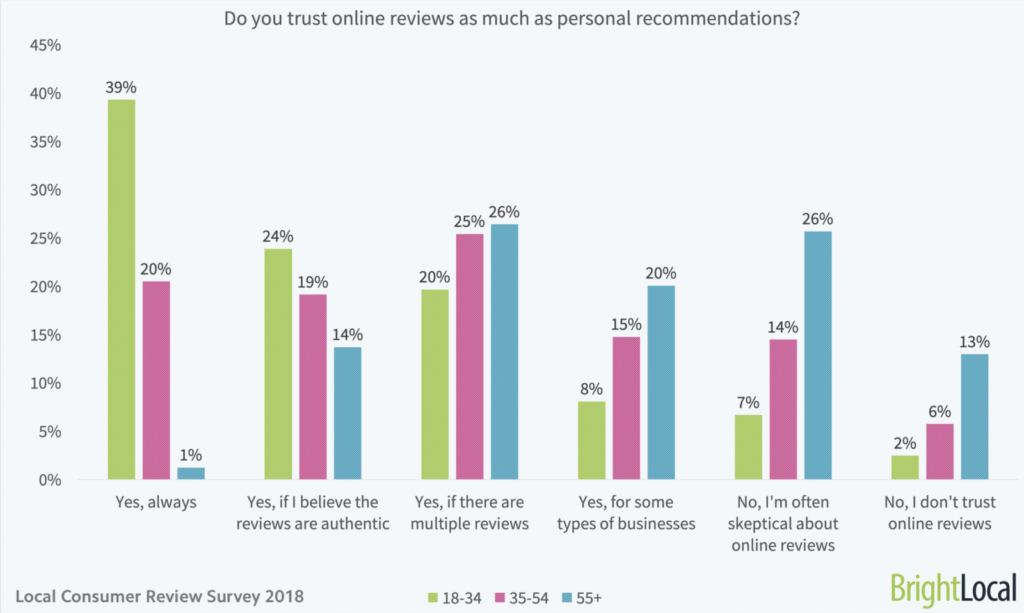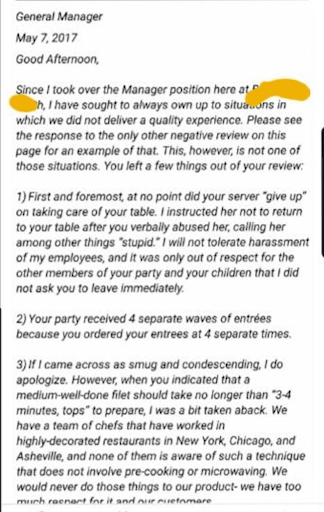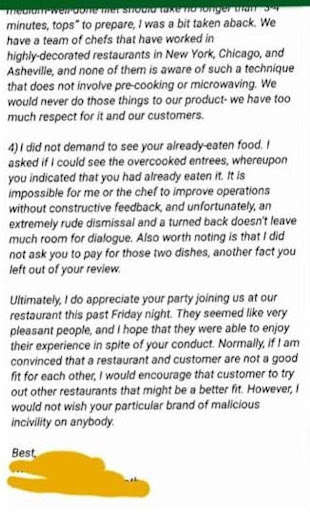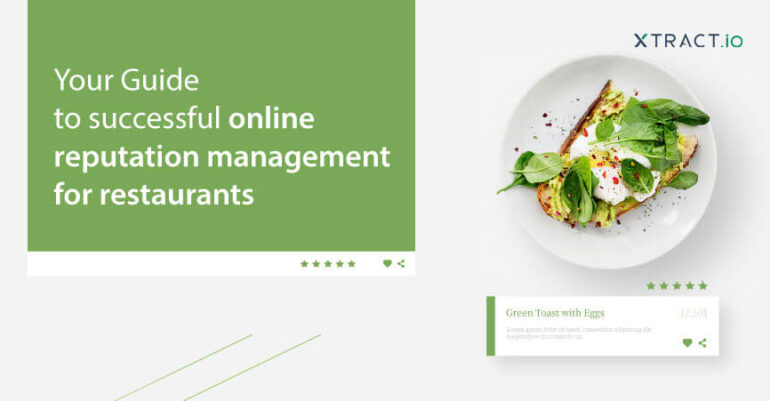Customers evaluate a restaurant on aspects beyond food. Things like Instagram lifestyle, love for pretty decors, and quality of dining experience are some factors that qualify a fine to dine experience and thereby good reviews and ratings.
90% of diners value online reviews as much as the opinions of their friends and family.
Now, good reviews not only help in attracting more customers but it adds strategic values to your business too. It helps you build a strong competitive edge, easily introduce new brands and product lines, improve overall credibility and investment opportunities.
The foundation of a good brand reputation drills down to the experience of customers shared online in the form of reviews, ratings, social media posts, comments, review blogs, mentions, and more. It is important to keep these sentiments favorable to help boost your restaurant visibility and brand credibility.
The real big question is how.
It is quite overwhelming to manage restaurant reputation as there are multiple channels to handle and certain complexities involved in analyzing and inferring insights through sentiment analysis.
This guide will help you identify different touchpoints and some tips and tricks to improve your online reputation and restaurant review management.
Let’s begin!
4 ways to smartly manage restaurant reputation online
1. Examine and analyze online reviews
Customers resort to multiple touchpoints. As for restaurants, there are crowd-sourced review forums like Yelp, Tripadvisor, Urbanspoon, online food order and delivery platforms like GrubHub, Doordash, and Swiggy and several social channels on which customers drop their reviews, feedback, and experience with your brand.
A one-star rating hike on Yelp can mean a 5% to 9% rise in restaurant revenue.
Hoarding positive reviews is important for your brand because it gives people who want to try you out – it could be tourists, food bloggers, folks who relocated, and more to get a complete picture of your brand that covers taste, ambiance, price, service, etc.
BrightLocal’s local consumer survey shows that 91% of consumers between the age of 18 to 34 trust online reviews, considering them as authentic as personal recommendations.

For instance, let’s say close to 60% of the reviews across different channels have pointed out that the hotel staff is not attentive and is unfriendly. This will help you implement a change that can fix this attitude. So, in addition to encouraging reviews from your customers, it is also important that you constantly monitor and analyze sentiments to make decisions that improve the overall image of your brand with social media and hospitality reputation management.
While you are using several tactics to collect customer feedback and it is important that you strike a balance between positive and negative reviews. A few negative reviews make potential customers see you as a credible and trustworthy brand. Hundreds and thousands of such reviews across websites and platforms in different structures and formats, when put together and analyzed will help you gauge important insights.
2. Understanding customer demographics
If you’re being constantly criticized for the culture your restaurant spreads, or the theme of your ambiance, the tone you set in your communication, the vibe you bring – it means you need to examine if you are targeting the right set of audience. Themed restaurants resonate only with a highly pinned down set of audiences.
Understanding customer demographics – their age, gender, preferred cuisine, if they dine with kids regularly (use tall chairs), spending habits if they are extravagant or otherwise. Understanding the demography of your customer will help you clear the cobwebs and create an atmosphere that resonates with them the best.
Customer demography is deeply connected with reputation because if your restaurant is attracting good reviews, you should analyze and categorize reviewers based on demographic aspects to answer key questions – why they like what they like. Reasoning out this will further help you personalize your messages and direct them to drop reviews on the right and relevant sites.
3. Know the millennial Instagram life
According to a new study by Maru/Matchbox, 69 percent of millennials take a photo (or a video) of their food before eating.
Have you come across Instagram handles of Shakeshack and Starbucks? These are really good examples of great brand and reputation building. They share photos and videos of people at work and encourage their employees to share photos, stories, and live videos too. By humanizing a brand, you build better engagement, gain authenticity, and can boost your overall revenue. Apart from this, be sure to respond to your customer comments and engagements quickly and re-gram UGC to help build your reputation further.
Posts with hashtags get 12% more engagement than those without. Identify the hashtags that resonate well with your geography and customer demography and encourage your customers to post photos by including them. It is not quite a task to approach your customers on this front considering the love and excitement that people have for food photos on Instagram. You can also work your way up by introducing your very own brand hashtag. Also, people use Instagram’s explore tool to find a new place to eat, so, following geolocation, a hashtag can really be lucrative.
As you keep building engagement on Instagram and gain loyal customers and followers, your reputation on Instagram will begin to matter as it would rank on search results and will probably be one of the main criteria for a user to assess your brand.

4. Identify influencers for your brand
A website that is wealthy with content resources has the potential to dominate the search results. Building blogs and articles and consistent social media presence will help you overcome the visibility of negative reviews on the Internet through search engine results.
Particularly for the restaurant industry, there are food bloggers for every region that customers usually rely upon. Partnering with such influencers can help you amplify your reach. Just be sure to check their social media presence, Alexa ranking, and daily visits to the website to evaluate their power of influence.
Here’s an interesting read on how Springbone kitchen, a Manhattan restaurant identified influencers to improve their reach and amplify their revenue.
Wrapping Up
The customer is king. The unpopular opinion on this is we treat them so as long as they are being reasonable. Restaurant reputation management is not just confined to handling customer concerns and complaints but also to see if they’re being fair and reasonable. There are “nightmare” customers who tarnish the brand image by spreading unsolicited opinions.
A few months back review of a restaurant in Asheville, North Carolina slammed the restaurant and called the staff “stupid”. The manager couldn’t take abusive comments and responded to the insatiable customer like this:


The whole other side of reputation management is standing up for yourself when customers are condescending and petty.
So, how do you manage your reputation consistently?
Your partner in restaurant reputation management – Get to know Xtract.io
Xtract.io helps companies around the globe and across industries manage their reputation online. We have over a decade of experience in online reputation management and have been a part of the success stories of many businesses around the globe. Our reputation management solutions have helped many digital marketers who have seen a visible change in the way their brand has improved its reputation management.
You can begin by talking to our experts to help you evaluate the need for a tool based on your reputation scores. Depending on your interaction and experience with us, we can further discuss how we can work together to help you understand your organization, its branding values, current reputation management efforts, and ways to improve it.
Our online reputation management solution can help your restaurant manage reviews online through automated responses based on the NLP-based classification of comments and reviews. We can help you manage online reputation and with hotel review management across different channels -community forums, newsfeed, all online mentions to name a few.
Let’s meet and talk about your reputation management needs, probably over coffee? We can suggest someplace nice 😉
This article was originally published on Productcoalition.









3 Comments
Hi, I’m Anwitasinha. While reading your article I got so many new and useful, knowledgeable things to implement and earn. Thanks for sharing this article and we always looking for your coming article to read. Keep sharing
Thank you for reading. Glad you liked the article. Xtract.io hopes to continue bringing useful information through blogs and other resources. You can find more articles on https://xtract.io/blog/
This blog offers valuable insights and practical tips for restaurants to effectively manage their online reputation. From monitoring online reviews to engaging with customers, it provides actionable steps for restaurants to establish a positive online presence and attract more customers. A must-read for any restaurant looking to enhance their reputation and increase their bottom line.